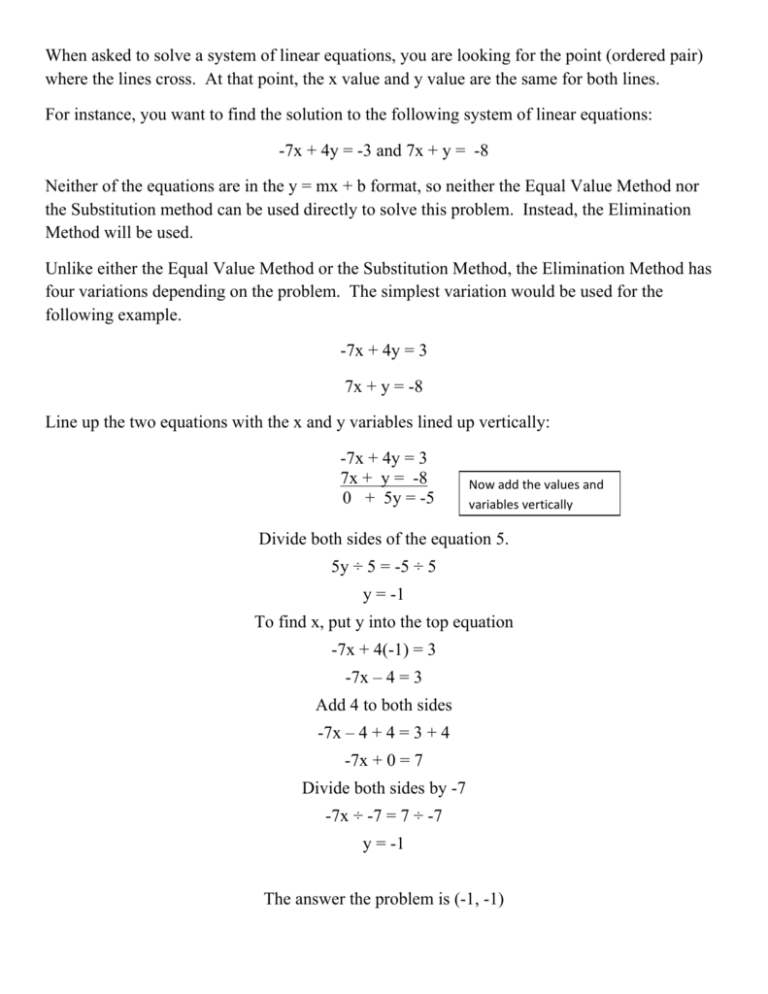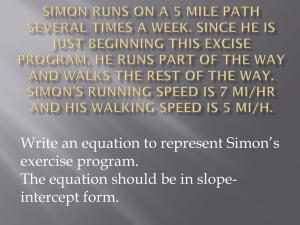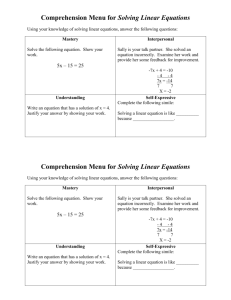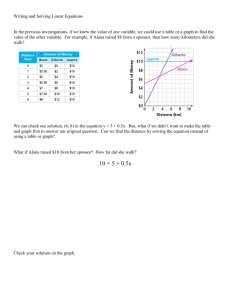When asked to solve a system of linear equations, you are looking
advertisement

When asked to solve a system of linear equations, you are looking for the point (ordered pair) where the lines cross. At that point, the x value and y value are the same for both lines. For instance, you want to find the solution to the following system of linear equations: -7x + 4y = -3 and 7x + y = -8 Neither of the equations are in the y = mx + b format, so neither the Equal Value Method nor the Substitution method can be used directly to solve this problem. Instead, the Elimination Method will be used. Unlike either the Equal Value Method or the Substitution Method, the Elimination Method has four variations depending on the problem. The simplest variation would be used for the following example. -7x + 4y = 3 7x + y = -8 Line up the two equations with the x and y variables lined up vertically: -7x + 4y = 3 7x + y = -8 0 + 5y = -5 Now add the values and variables vertically Divide both sides of the equation 5. 5y ÷ 5 = -5 ÷ 5 y = -1 To find x, put y into the top equation -7x + 4(-1) = 3 -7x – 4 = 3 Add 4 to both sides -7x – 4 + 4 = 3 + 4 -7x + 0 = 7 Divide both sides by -7 -7x ÷ -7 = 7 ÷ -7 y = -1 The answer the problem is (-1, -1) The next example requires one additional step because the neither the x variable nor the y variable can be eliminated directly. 5x + 5y = -25 -8x + 5y = 14 Multiply one of the equations by -1 so that the y value can be eliminated. (-1)(5x + 5y) = (-1)(-25) -5x – 5y = 25 Line up the two equations with the x and y variables lined up vertically: -5x – 5y = 25 -8x + 5y = 14 -13x + 0 = 39 Now add the values and variables vertically Divide both sides of the equation by -13 -13x ÷ -13 = 39 ÷ -13 x = -3 To find y, put the x value into the top equation 5(-3) + 5y = -25 -15 + 5y = -25 Add 15 to both sides -15 + 5y + 15 = -25 + 15 5y = -10 Divide both sides by 5 5y ÷ 5 = -10 ÷ 5 y = -2 The answer the problem is (-3, -2) The next example is more difficult because the one additional step requires some thought to determine which variable to eliminate. -6x – 7y = -18 -10x + 14y = -30 In this example, the top equation would be multiplied by 2 so that the y variable can be eliminated. (2)(-6x-7y) = (2)(-18) -12x – 14y = -36 Line up the two equations with the x and y variables lined up vertically: -12x – 14y = -36 -10x + 14y = -30 -22x = 0 = -66 Add the values and variables vertically Divide both sides by -22 -22x ÷ -22 = -66 ÷ -22 x=3 To find y, put the x value into the top equation -6(3) – 7y = -18 -18 – 7y = -18 Add 18 to both sides -18 – 7y + 18 = -18 + 18 -7y = 0 Divide both sides by -7 -7y ÷ -7 = 0 ÷ -7 y=0 The answer to the problem is (3, 0) The final example is the hardest because there are two additional steps and requires some thought to determine which variable to eliminate. -3x – 4y = 11 -4x + 3y = -27 In this example, the top equation would be multiplied by 3 and the bottom equation would be multiplied by 4 so that the y variable can be eliminated. (3)(-3x – 4y) = (3)(11) (4)(-4x + 3y) = (4)(-27) -9x – 12y = 33 -16x + 12y = -108 Line up the two equations with the x and y variables lined up vertically: -9x – 12y = 33 -16x + 12y = -108 -25x + 0 = -75 Add the values and variables vertically Divide both sides by -25 -25x ÷ -25 = -75 ÷ -25 x=3 To find y, put the x value into the top original equation -3(3) – 4y = 11 -9 – 4y = 11 Add 9 to both sides -9 – 4y + 9 = 11 + 9 -4y + 0 = 20 Divide both sides by -4 -4y ÷ -4 = 20 ÷ -4 y = -5 The answer to the problem is (3, -5)








